The Baltic harbour porpoise: on the road to extinction
By Mark P. Simmonds, Ida Carlén, and Laetitia Nunny.
Whilst most readers of The Marine Biologist will certainly recognize the harbour porpoise Phocoena phocoena, the general public in the UK, and elsewhere in Europe, will likely not (we know this because we have asked a good sample of them). The porpoises’ surface behaviour is usually rather low key (Fig. 1) and, as one of the world’s smallest cetaceans, they often go unseen. This low public recognition means there is limited pressure on politicians to take action for their conservation. This situation is most critical in the Baltic Sea, where the porpoise is in the middle of a fight between naval interests, fishers and conservationists.
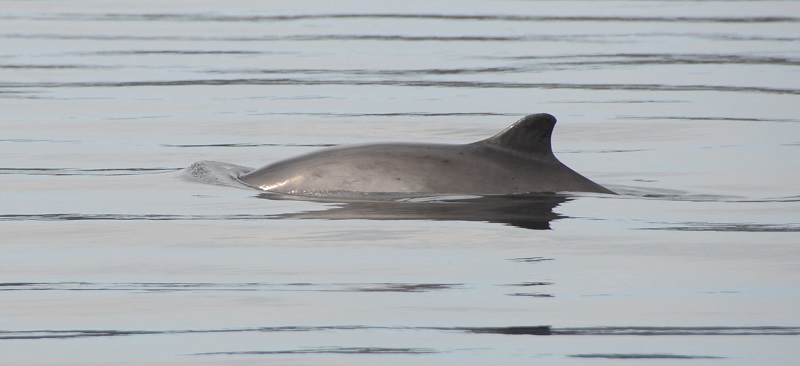
Figure 1. The typically low profile of a harbour porpoise seen here against a calm sea. ©Anik Boileau/CERSI.
There are 16 distinct populations of harbour porpoise in the North Atlantic region and their range stretches from Greenland to the Baltic Sea and from the Barents Sea to the coasts of France and the Iberian Peninsula. It is a native species in at least 24 countries. Here we focus on the population in the main basin of the brackish Baltic Sea, the ‘Baltic Proper’ (distribution shown in Fig. 2), which is believed to have occupied this area for around 9,000 years.
The porpoise of the Baltic Proper—a distinct and critically endangered population
In the 1950–1970s, the Baltic harbour porpoise seemed to undergo a major population collapse and the most recent estimate suggests that the population now consists of only a few hundred individuals.
The Baltic harbour porpoises are distinct from their closest neighbours in the Belt Sea. There are small but significant differences in genetics as well as skull shape. Their distinctiveness is also supported by spatial data from satellite tagged animals from the Belt Sea population and a large-scale acoustic survey (known as SAMBAH), which was carried out in the Baltic Proper in 2011–2013.
The population was declared ‘critically endangered’ by the IUCN in 2008. Since then, other expert bodies, including the Scientific Committee of the International Whaling Commission (IWC) and ASCOBANS (the regional agreement for small cetaceans), have repeatedly called for action to better protect it.
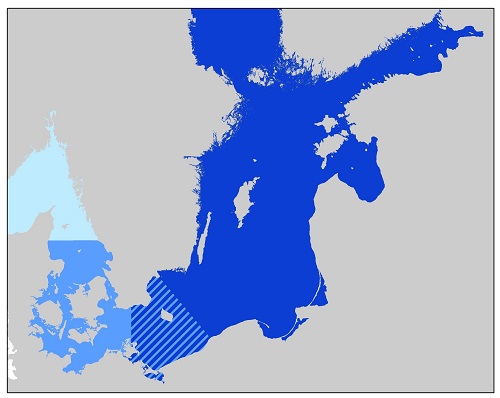
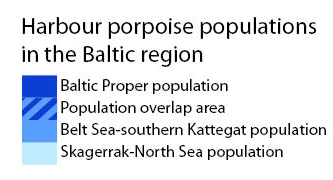
Figure 2. Map of Baltic harbour porpoise distribution.
Threats to the Baltic harbour porpoise
The population crash seen in the last century has been driven by several factors, including hunting which occurred until the end of the Second World War. The Baltic Sea is highly polluted and there have long been concerns about the effects of persistent pollutants on the health and reproduction of the resident marine mammals, which, in addition to the harbour porpoise, include grey seals Halichoerus grypus, harbour seals Phoca vitulina, and ringed seals Pusa hispida. These apex predators tend to have very high levels of pollutants in their bodies and, based on studies from the UK in combination with knowledge on levels of PCBs (polychlorinated biphenyls) in Baltic harbour
porpoises, it is reasonable to surmise that their reproduction is significantly suppressed by their contaminant loads. Additionally, female harbour porpoises reach sexual maturity at around 4–5 years of age, but research has indicated that harbour porpoises in some areas of the Baltic rarely live longer than 4 years.
The most immediate threat to the harbour porpoise is becoming bycatch in fishing nets set to catch, for example, cod, flatfish, or salmon. The death of just one harbour porpoise, especially one of the rare fertile females, could cause the population to crash and should be seen in relation to the estimated current bycatch of three to seven animals per year.
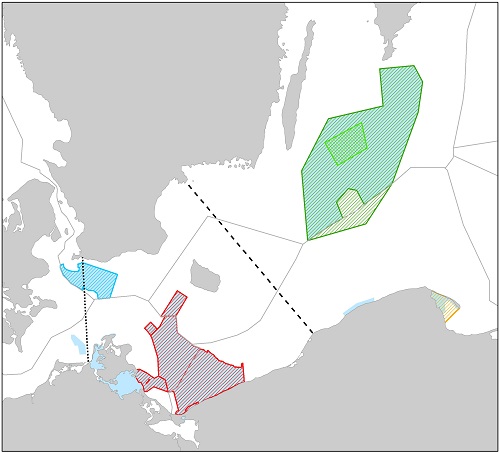
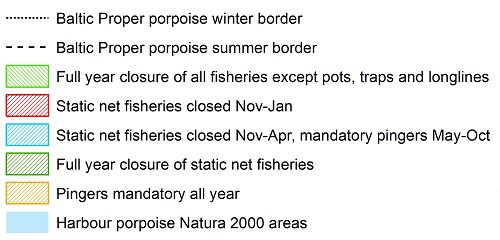
Figure 3. Areas where there are fisheries regulations in place to mitigate harbour porpoise bycatch in the Baltic.
Conservation challenge
Despite everything that is known about the perilous situation of the Baltic harbour porpoise, there were no effective conservation measures in place anywhere in its range until very recently. In May 2020, at the request of the European Commission, the International Council for the Exploration of the Sea (ICES) published scientific advice on emergency measures to prevent bycatch of the Baltic harbour porpoise. The advice proposes closures of static net fisheries in Marine Protected Areas (MPAs) designated for the harbour porpoise and other core areas for the population, and the use of acoustic deterrent devices (ADDs or ‘pingers’) on fishing nets in the rest of the population range.
Then in 2020–2021, two Joint Recommendations were submitted by the Baltic Sea regional fisheries body, BALTFISH, to the European Commission, and in February 2022, a Delegated Act based on the Recommendations came into force. The Act closed static net fisheries in important harbour porpoise MPAs as well as one other important area, some all year round and some part of the year, depending on their location in relation to the known seasonal distribution of the Baltic population (Fig. 3). The Act also stipulates mandatory pinger use in two MPAs. These are the first conservation measures ever taken to protect the Baltic harbour porpoise and come several decades after the first calls for its protection were made.
These measures are not enough. At the start of 2023, a coalition of conservation organizations wrote to the relevant authorities, noting that according to the ICES advice, bycatch must be mitigated throughout the entire population range through obligatory use of pingers in all static net fisheries where no closures are in effect. However, in 2021, the military forces of three Baltic Sea countries raised concerns about pingers interfering with military underwater acoustic activities such as sonars, and refused to accept large-scale use of pingers. This includes Sweden, where 98 per cent of the harbour porpoise population is thought to reside during the summer reproductive season, and conservationists are now calling for other measures to minimize bycatch if pingers cannot be used. This is supported by a petition from over 120,000 people calling for the protection of the Baltic harbour porpoise.
Harbour porpoise vital statistics
- Family: Phocoenidae
- Species: Phocoena phocoena
- Distribution: temperate and subarctic waters in the northern hemisphere
- Average length: 1.5 m
- Appearance: small, rotund body, small head with no forehead or beak, short, rounded flippers and triangular dorsal fin. Dark grey with a paler underside.
- Social structure: appears relatively solitary, although groups are sometimes seen and may be associated with concentrations of prey.
- Average life expectancy: The species can live to 25 years but in the wild rarely beyond 12 and far less in the Baltic (see main text).
- Gestation: 10–11 months
- Lactation: 8–11 months
It is likely that the Convention on the Conservation of Migratory Species of Wild Animals (CMS) will consider the Baltic harbour porpoise at its next meeting of parties, which will be held in October this year in Uzbekistan. Ideally, given its critically endangered status, it should be added to the Convention’s Appendix 1, which would underpin further conservation action.
Conclusion
Pingers are used in many countries around the world, and nowhere in any previous deployment has there been any suggestion that they interfere with military activities. In this situation, of course, national security holds the trump card, making dialogue almost impossible. However, we sincerely hope that the military forces present in the Baltic Sea Region are willing to look more closely at this potential problem, recognizing that the survival of the only cetacean in the Baltic Sea Proper hangs in the balance.
• Mark P. Simmonds1,2 (msimmonds@oceancare.org),
• Ida Carlén3
• Laetitia Nunny1
1 OceanCare, https://www.oceancare.org
2 Veterinary School, University of Bristol
3 The Swedish Society for Nature Conservation (SSNC), https://www.naturskyddsforeningen.se
Further reading
ASCOBANS 2016. Recovery Plan for Baltic Harbour Porpoises (Jastarnia Plan). Agreement on the Conservation of Small Cetaceans of the Baltic, North East Atlantic, Irish and North Seas. 94 p. www.ascobans.org/en/document/ascobans-recovery-plan-baltic-harbour-porpoises
Carlén I., Nunny L. and Simmonds M.P. 2021. Out of sight, out of mind: how conservation is failing European porpoises. Frontiers in Marine Science 8. DOI=10.3389/fmars.2021.617478
Evans P.G.H. 2020. European Whales, Dolphins and Porpoises. Academic Press, London.
Hammond P.S., Bearzi G., Bjørge A., Forney K.A., Karczmarski L., Kasuya T., Perrin W., Scott M.D., Wang J.Y., Wells R.S. and Wilson, B. 2008. Phocoena phocoena (Baltic Sea subpopulation) (errata version published in 2016). The IUCN Red List of Threatened Species 2008: e.T17031A98831650. dx.doi.org/10.2305/IUCN.UK.2008.RLTS.T17031A6739565.en.
Save the Baltic Harbour Porpoise petition. you.wemove.eu/campaigns/save-the-baltic-harbour-porpoise
